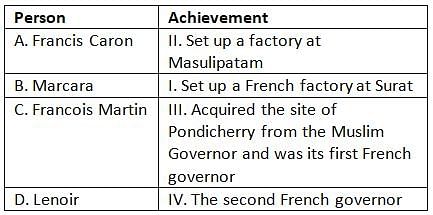Test: Beginning of European Commerce- 1 - UPSC MCQ
30 Questions MCQ Test History for UPSC CSE - Test: Beginning of European Commerce- 1
Who is the first President of the Council of Fort William?
When and to whom did the Danes sell all their settlements in India?
What is the historical sequence of the establishment of the following French factories?
I. Mahe
II. Surat
III. Masulipatnam
IV. Pondichery.
Arrange the following chronologically:
I. Fracois Martin
II. Lenoir
III. Dumas
IV. Dupleix
V. Count de Lally
At which of the following places on the West coast the English had their factories?
I. Ahmedabad
II. Bassein
III. Salsette
IV. Broach
V. Baroda
Why did it become essential for European powers to find an alternative route to India in the fifteenth century?
I. It was dictated by the mercantilist policies followed by European nations.
II. Most trade routes were blocked because the Turks controlled them.
III. They bought goods from the Turks by paying several times the original prices.
Vasco-de-Gama established friendly relations with the Zamorin who was the ruler of
Most European powers reached India after crossing the
The Portuguese built their first fort on Indian soil in the territory of the Raja of
Who was appointed as the first Viceroy of the Portuguese possessions in India?
When the Portuguese arrived in India, most of the Indian trade was in the hand of the Arabs who
The resistance from Arab traders was completely crushed by the Portuguese under
In the sixteenth century bulk of the Portuguese trade was with
Which of the following died in 1515 and was buried at Goa?
The foundation of the Portuguese maritime empire in India was truely laid under Albuquerque when
During the period when the Portuguese had commercial links with India the rulers in India enjoyed a monopoly over
With the coming of the Portuguese the complexion of Indian trade changed in the sense that
The Portuguese attempt to control the seaborne trade of the Indian sub-continent was made partially ineffective through
Which one of the following statements does correctly illustrate that the Portuguese landing in India was fortunate both as to place and time?
The centre of Portuguese power in India was
Which is true about the Portuguese in India?
Which crop was not introduced in India by the Portuguese?
The United East India Company of the Netherlands was established in
The Dutch established themselves at Masulipatam after obtaining a farman from the ruler of
The Dutch had a stronger navy than the Portuguese. Nevertheless, the Dutch soon realized that it was difficult to trade profitably in pepper and spices in the east without the aid of
Which was the main centre of Dutch trade in the Coromandel until the headquarters were shifted to Negapatam in 1690?
Which event marked the beginning of European commercial expansion into Asia during the 15th century?
|
112 videos|505 docs|173 tests
|





















